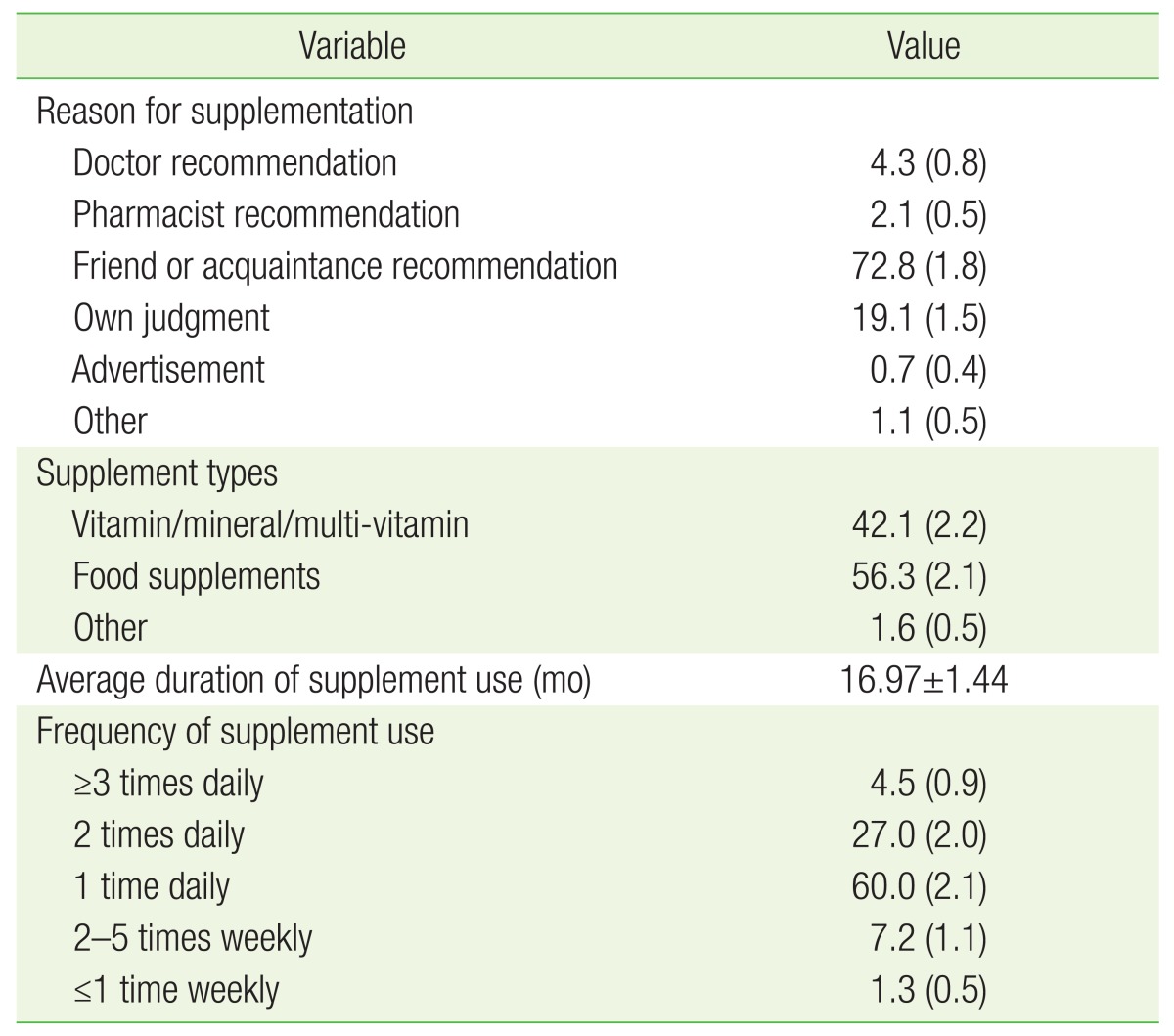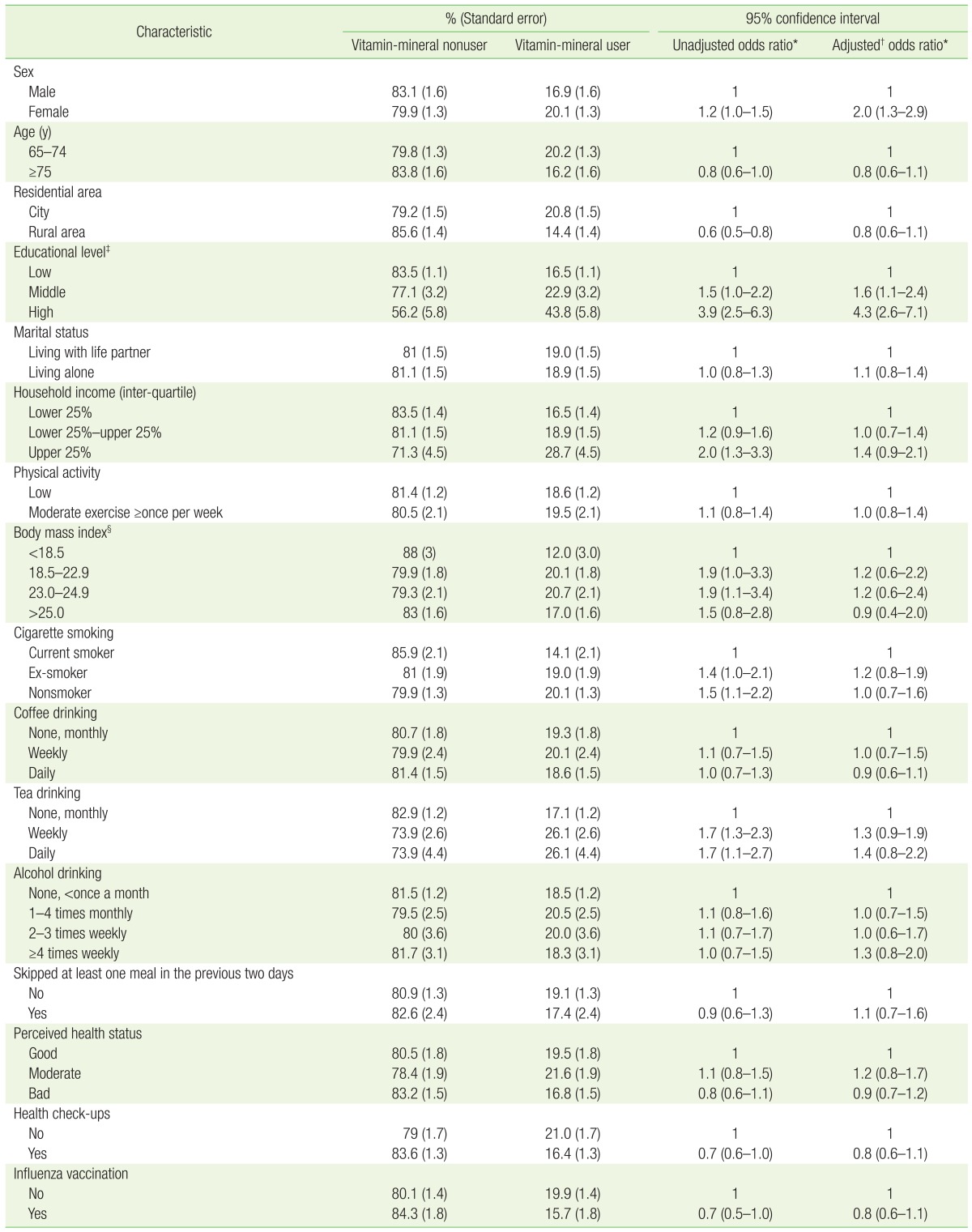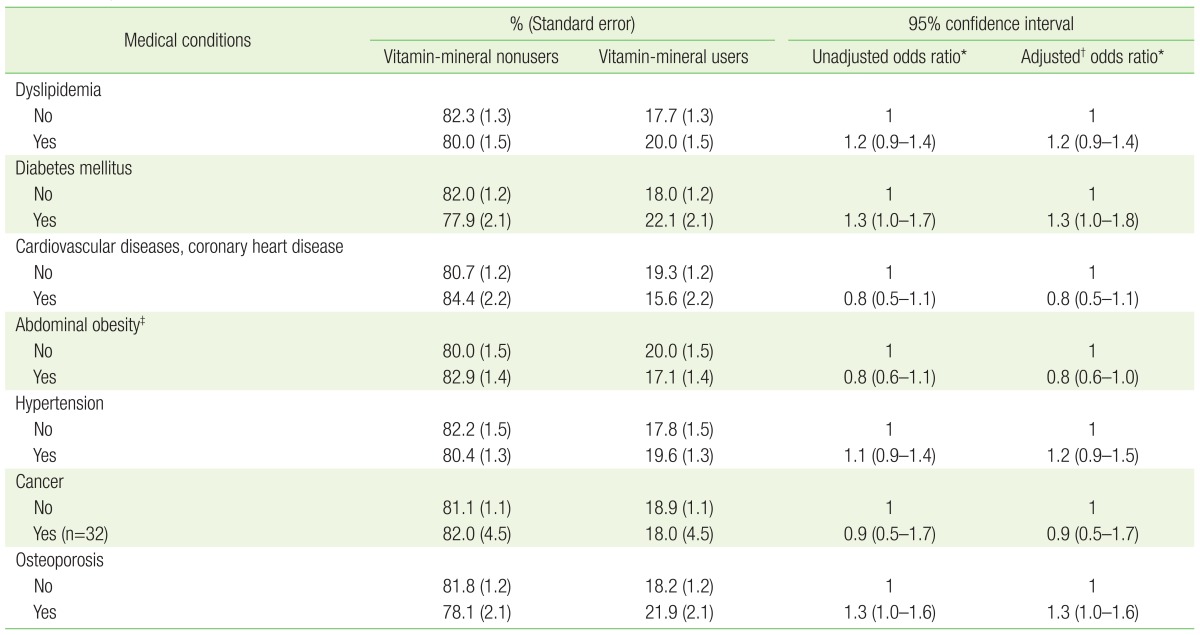Vitamin-Mineral Supplement Use Patterns in Elderly Koreans: Data from the 2007–2008 Korean National Health and Nutrition Examination Survey
Article information
Abstract
Background
Vitamin-mineral supplements are the most popular dietary supplements in Korea. However, few studies have assessed the relationship between vitamin-mineral supplementation and associated factors among the Korean elderly. The purpose of this study was to assess the use of vitamin-mineral supplements among elderly in Korea as well as its association with sociodemographic factors, health-related behaviors, medical conditions, and nutrient intake.
Methods
This study was based on data from the Korean National Health and Nutrition Examination Survey, conducted by the Korean Ministry of Health and Welfare from 2008 to 2009. Data from 3,294 elderly men and women (65 years of age and older) were analyzed. Multivariable-weighted logistic regression model analysis was used to evaluate the association between vitamin-mineral supplement use and sociodemographic factors, health-related habits, and medical conditions.
Results
Vitamin-mineral supplementation was reported by 16.3% of the participants. The most common reason for using dietary supplements was recommendations from friends and acquaintances. Highly educated person, female participants had a greater likelihood of taking vitamin-mineral supplements. In addition, analysis of nutrient intake from food sources alone revealed a lower proportion of vitamin-mineral supplement users with nutrient intakes below the estimated average requirements for vitamin A, vitamin C, thiamine, riboflavin, niacin, calcium, iron, and phosphorus, compared to nonusers. However, vitamin-mineral supplementation was not associated with health-related behaviors or medical conditions.
Conclusion
Highly educated person, elderly Korean women had a greater likelihood of using vitamin-mineral supplements. In addition, nutrient intakes from food sources alone were significantly higher among vitamin-mineral supplement users. Finally, vitamin-mineral supplementation may be an indicator of healthier diet in elderly Koreans.
INTRODUCTION
Vitamin-mineral supplements are the most popular dietary supplement in Korea. According to the fourth Korean National Health and Nutrition Examination Survey (KNHANES), approximately 16% of men and 26% of women aged 19 years and over reported using vitamin-mineral supplements.1) Vitamin-mineral supplements are also the most common dietary supplements in the United States and Europe.234)
The results of a previous cohort study revealed that vitamin-mineral supplementation reduced the risk of myocardial infarction by 30%, and longer duration of supplementation was associated with further reduced risk.5) Another meta-analysis reported that intake of vitamin supplements including the antioxidants vitamins C and E reduced glycated hemoglobin (A1c) levels.6) In addition, daily vitamin-mineral supplementation prevented colorectal cancer and was associated with a reduction in total cancer, especially in men.78)
With increasing evidence of the effect of vitamin-mineral supplementation on disease prevention and cure, studies on the prevalence of supplement use and factors related to their use are also increasing. Previous research has indicated that older age,4910) female sex,111213) higher educational level,41112) lower body mass index,10) higher economic status,101314) physical activity,911) and healthier diet910111214) are associated with increased use of vitamin-mineral supplements.
Many studies in Korea have assessed the prevalence of supplement use and characteristics in Korean children, adolescents, and adults,101214) but research in the elderly has mainly focused on the nutritional aspects, and there has been no nationally representative survey.13) Therefore, the purpose of this study was to describe the use of vitamin-mineral supplements among elderly Koreans, along with the sociodemographic factors, health-related behaviors, medical conditions, and nutrient intake associated with its use.
METHODS
1. Study Participants
This study was based on the fourth KNHANES conducted by the Korea Centers for Disease Control and Prevention. From 2008 to 2009, a total of 8,000 households and 20,277 people were enrolled. Data from 3,294 elderly men and women (above 65 years of age) were analyzed, with no exclusions.
2. Study Method
The KNHANES,15) a nationwide study, examined the general health and nutritional status of Koreans. Participants were selected based on data from the Population and Housing Census. The fourth KNHANES included all individuals and households in the 2005 Population and Housing Census.
The KNHANES database is divided into three categories: health interview survey, nutritional survey, and health examination survey. The health interview and examination surveys were conducted in mobile examination units by individual interviewers. The nutritional survey included questions regarding diet behavior, dietary supplement intake, and nutritional knowledge. Food and nutrient intakes were assessed using self-reported data obtained from a one-day (24-hour) recall of the day prior to administration of the survey.
1) Sociodemographic factors
The health interview survey collected data regarding participant age, sex, residential area, educational level, and household income, physical activity, cigarette smoking, alcohol drinking, and tea drinking.
2) Health behaviors and general medical comorbidities
Body mass index was calculated from measured height and weight (kilograms/meters squared). Abdominal obesity was defined the measured waist circumferences ≥90 cm in men or ≥85 cm in women.16) Medical conditions, including dyslipidemia, diabetes mellitus (DM), cerebrovascular disease (CVD), coronary heart disease (CHD), hypertension, osteoporosis, and cancer (gastric, liver, breast, lung, or cervical), were assessed by interview. In addition, participants with measured blood pressures ≥140/90 mm Hg were classified as hypertensive; those with measured hemoglobin A1c levels ≥6.5% were classified as having DM; and total cholesterol ≥240 mg/dL, high density lipoprotein cholesterol <40 mg/dL, and triglyceride levels ≥200 mg/dL were suggestive of dyslipidemia; in addition, participants previously clinically diagnosed with these conditions were classified as having these diseases.
3) Health behaviors
Regular diet behavior was assessed by asking participants if they had skipped any meals during the previous one and two days. Self-reported health statuses were classified as 'good,' 'moderate,' or 'bad.' Regular health check-ups and influenza vaccinations were also assessed.
4) Vitamin-mineral supplement use
Vitamin-mineral supplement users were defined as participants who replied "Yes" to the question, "Do you take a vitamin-mineral supplement?" The reasons, categories, duration, and frequency of vitamin-mineral and other dietary supplement use were also assessed.
5) Nutrient intake from food sources
The analysis of nutrient intake from food alone included eight nutrients: vitamin A, vitamin C, thiamine, riboflavin, niacin, calcium, iron, and phosphorus. The percentages of participants with nutrient intakes below the estimated average requirement (EAR) were calculated. Food and nutrient intakes were assessed by the one-day, 24-hour recall method.
3. Statistical Analysis
KNHANES offers multistage, stratified, and complex survey sampling data; complex sample design analysis was used in the current study. Sampling weight was calculated based on the number of sampled units, according to KNHANES guidelines.
The reasons, categories, duration, and frequency of vitamin-mineral and other dietary supplementation were calculated by frequency analysis. Odds ratios (ORs) and 95% confidence intervals (CIs) were calculated using a multivariable-weighted logistic regression model to evaluate the association between vitamin-mineral use and demographic factors, lifestyle characteristics and health behaviors, and medical conditions. Multivariable-weighted logistic regression was also used to compare the ratio of participants with nutrient intake from food alone below the EAR between vitamin-mineral user and nonuser. All statistical analyses were performed using SAS ver. 9.3 (SAS Institute Inc., Cary, NC, USA) or PASW SPSS Statistics for Windows ver. 18.0 (SPSS Inc., Chicago, IL, USA), with a level of significance of P<0.05.
RESULTS
Among 3,294 elderly aged 65 years and above, 537 (16.3%) reported using vitamin-mineral supplements. The mean participant age was 72 years and 40.6% were men.
1. Reason, Category, Duration, and Frequency of Dietary Supplement Use
The most common reason for dietary supplement use was recommendation from friends and acquaintances (72.8%). The elderly in Korea prefer functional foods (56.3%) to vitamin-mineral supplements (42.1%). The mean duration of supplement use was about 17 months, and most reported taking supplements once per day (60%) (Table 1).
2. Demographic and Lifestyle Characteristics, and Health Behaviors among Vitamin-Mineral Supplement Users
Before adjusting for demographic, lifestyle characteristics, and health behaviors, vitamin-mineral supplementation was associated with higher household income (OR, 2.0; 95% CI, 1.3–3.3), city living (OR, 0.6; 95% CI, 0.5–0.8), higher education level (OR, 3.9; 95% CI, 2.5–6.3), nonsmoking (OR, 1.5; 95% CI, 1.1–2.2), and drinking tea more than once a week (OR, 1.7; 95% CI, 1.3–2.3). However, after adjustment, the likelihood of vitamin-mineral supplement use was greater if participants were female (adjusted OR, 2.0; 95% CI, 1.3–2.9), and with a higher education level (adjusted OR, 4.3; 95% CI, 2.6–7.1); there was no association between supplement use and other demographic and lifestyle characteristics. In addition, health behaviors such as regular diet, selfreported health status, regular health check-ups and influenza vaccination were not related to use of vitamin-mineral supplements (Table 2).
3. Medical Condition among Vitamin-Mineral Supplement Users
There was no significant difference between vitamin-mineral supplement use and the incidence of hypertension, DM, dyslipidemia, CVD, CHD, osteoporosis, cancer, and abdominal obesity (Table 3).
4. Nutrient Intakes from Food Alone (Except for Supplements) among Vitamin-Mineral Supplement Users
Table 4 summarizes nutrient intakes from food alone among vitaminmineral supplement users and nonusers. The proportions of participants with nutrient intakes below the EAR were calculated for men and women separately. Food and nutrient intakes were assessed using the one-day, 24-hour recall method. Analysis of nutrient intake from food sources alone revealed a lower proportion of participants with vitamin A, vitamin C, thiamine, riboflavin, niacin, calcium, iron, and phosphorus nutrient intakes below the EAR among vitamin-mineral supplement user than among nonusers.
DISCUSSION
We investigated the prevalence of vitamin-mineral supplement use and the characteristics of these users among Korean elderly. In current study, about 16.3% of elderly Koreans reported using vitamin-mineral supplements. The most common reason for their use was recommendation from friends and acquaintances, (73%), compared to doctor recommendation, at only 4.3%. This result suggests that participants didn't get Information about dietary supplement from health professionals. Therefore, health professionals should inquire about supplement use and provide patients with specific information.
Before adjusting for sociodemographic factors and health-related higher household income behaviors, vitamin-mineral supplement use was associated with city living, higher education level, nonsmoking, and drinking tea more than once a week. After adjusting, highly educated person, female participants had a greater likelihood of using vitamin-mineral supplements.
A previous study using KNHANES data from Korean adults (20 years of age and older) reported that vitamin-mineral supplement use was associated with older age and higher household income,10) but the current study did not observe a similar association. However, our findings were in agreement with another study of Korean elderly. Song and Kim13) assessed patterns of vitamin-mineral supplement use by the elderly in Korea. Vitamin-mineral users were more likely to be female, live in the city, be more educated, and have higher household incomes compared with nonusers.
The vitamin-mineral supplement users did not have any association to medical conditions. Lee and Kim10) reported that participants with bone disease more commonly reported vitamin supplementation. Similarly, the Physicians' Health Study cohort study in the US found that men with history of hypercholesterolemia, cancer, and hypertension were more likely to use multivitamins.9)
The differences in findings between our study and previous studies are probably because our study focused on the elderly population. During the same period (2007–2009), the KNHANES reported that dietary supplement use was higher in middle-aged than in older adult Koreans.12) However, in the US, multivitamin use was more common in older people than among those of middle age.17) This result suggests that vitamin-mineral supplementation is less prevalent among the elderly in Korea, which may partially explain the lack of association between vitamin-mineral use and medical conditions. However, the link between vitamin-mineral supplement use and medical conditions requires further research.
Health behaviors, regular diet behavior, self-reported health status, regular health check-up, and influenza vaccination were not related to use of vitamin-mineral supplements. According to the 1999–2000 US National health and nutrition examination survey (NHANES), the use of dietary supplements was higher among those who perceived their health status as good.2) In contrast, data from the European Prospective Investigation into Cancer and Nutrition and other studies in Germany, the Netherlands, Sweden, and Denmark showed higher use of dietary supplements in those who perceived their health status as moderate or poor.31819) One might hypothesize that people in the US use dietary supplements to prevent diseases, whereas people in Europe use dietary supplements to treat diseases.20) According to a previous study of Korean elderly, the most commonly reported reasons for using vitamin-mineral supplements were to stay healthy (37.6%) and to relieve fatigue (22.3%), suggesting that use of dietary supplements among the elderly in Korea as a preventive measure.13)
In both men and women intake of all nutrients assessed in this study (vitamin A, vitamin C, thiamine, riboflavin, niacin, calcium, iron, and phosphorus) from food sources alone were significantly higher in vitamin-mineral supplement users. These results are consistent with those of previous studies reporting that dietary supplement users consumed more nutritious diets than nonusers.212171921) Pouchieu et al.22) examined daily food intakes among dietary supplement users and non-users, observing healthier diets overall among dietary supplement users compared to nonusers—they ate more vegetables, fruits, wholegrain foods, fish/seafood, and ate less poultry, processed meat, cakes/biscuits/pastries, and snacks/pizzas and drank fewer alcoholic beverages. In addition, according to the 2007–2008 NHANES in the US, a large number of participants taking dietary supplements satisfied EAR from food sources alone, without use of dietary supplements.17) These results are consist with previous studies reporting that vitaminmineral supplement users had overall healthier profiles.
This study has some limitations. First, the KNHANES data were based on a cross-sectional study design; thus, the current study could only suggest associations, rather than causality. Second, vitamin-mineral supplement use and medical conditions were assessed by self-reported data, which are subject to recall bias. Finally, the ratio of participants with nutrient intakes below the EAR from food sources alone was calculated using the one-day, 24-hour recall method, which might not reflect usual dietary habits.
However, the strength of this study is its use of data from the KNHANES, a nationally representative survey, which increases the reliability of the results. To our knowledge, this is the first study to use KNHANES data to analyze vitamin-mineral supplementation among the elderly in Korea.
In conclusion, highly educated person, elderly women in Korea had a greater likelihood of using vitamin-mineral supplements. In addition, the ratio of nutrient intake from food sources alone was higher among vitamin-mineral supplement users than nonusers. The results of our study suggest that vitamin-mineral supplement use may be an indicator of healthier diet in the elderly; however, this observation requires further validation. Health professionals should routinely determine supplement use history and provide patients with specific information.
Notes
CONFLICT OF INTEREST: No potential conflict of interest relevant to this article was reported.



